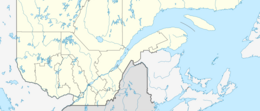| Fort Senneville | |
|---|---|
| Part of Montreal's outlying forts | |
| Senneville, Quebec, Canada | |
 Fort Senneville in 1895 | |
| Coordinates | 45°25′33″N 73°58′28″W / 45.42585°N 73.974402°W |
| Type | castle-like fort |
| Site information | |
| Controlled by | New France[1] |
| Condition | Some ruins remain |
| Site history | |
| Built | 1671 |
| Built by | Séminaire de Saint-Sulpice |
| In use | 1671-1763[1] |
| Materials | Stone, wood |
| Demolished | 1776 |
| Battles/wars | Iroquois incursions American Revolution |
Fort Senneville is one of the outlying forts of Montreal, Quebec, Canada, built by the Canadiens of New France near the Sainte-Anne-de-Bellevue in 1671. The property was part of a fief ceded to Dugué de Boisbriant in 1672 by the Sulpicians. A large stone windmill, which doubled as a watch tower, was built on a hill by late 1686 and featuring machicolation and other castle-like features. The fort was burned down by Iroquois in 1691, with only the mill itself left standing.
Governor-General Frontenac ordered the construction of a second, more imposing fort in 1692. It was rebuilt in 1702–1703 to protect the nearby fur trading post. With extensive cannons and swiveling wall guns, it was the "most substantial castle-like fort" near Montreal.[2] It was eventually destroyed in 1776 by Benedict Arnold, under American military control, but the ruins have been maintained since then. In 2003, it was classified as a historic site.
- ^ a b It ever saw military use only under New France. The land itself has been in British/Canadian territory ever since.
- ^ Chartrand 2005, p. 38
